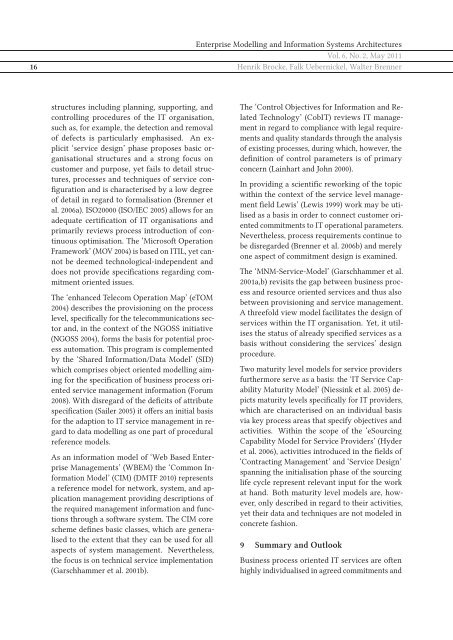Kundenorientierte Gestaltung und Vereinbarung standardisierter IT ...
Kundenorientierte Gestaltung und Vereinbarung standardisierter IT ...
Kundenorientierte Gestaltung und Vereinbarung standardisierter IT ...
Erfolgreiche ePaper selbst erstellen
Machen Sie aus Ihren PDF Publikationen ein blätterbares Flipbook mit unserer einzigartigen Google optimierten e-Paper Software.
Enterprise Modelling and Information Systems Architectures<br />
Vol. 6, No. 2, May 2011<br />
16 Henrik Brocke, Falk Uebernickel, Walter Brenner<br />
structures including planning, supporting, and<br />
controlling procedures of the <strong>IT</strong> organisation,<br />
such as, for example, the detection and removal<br />
of defects is particularly emphasised. An explicit<br />
‘service design’ phase proposes basic organisational<br />
structures and a strong focus on<br />
customer and purpose, yet fails to detail structures,<br />
processes and techniques of service configuration<br />
and is characterised by a low degree<br />
of detail in regard to formalisation (Brenner et<br />
al. 2006a). ISO20000 (ISO/IEC 2005) allows for an<br />
adequate certification of <strong>IT</strong> organisations and<br />
primarily reviews process introduction of continuous<br />
optimisation. The ‘Microsoft Operation<br />
Framework’ (MOV 2004) is based on <strong>IT</strong>IL, yet cannot<br />
be deemed technological-independent and<br />
does not provide specifications regarding commitment<br />
oriented issues.<br />
The ‘enhanced Telecom Operation Map’ (eTOM<br />
2004) describes the provisioning on the process<br />
level, specifically for the telecommunications sector<br />
and, in the context of the NGOSS initiative<br />
(NGOSS 2004), forms the basis for potential process<br />
automation. This program is complemented<br />
by the ‘Shared Information/Data Model’ (SID)<br />
which comprises object oriented modelling aiming<br />
for the specification of business process oriented<br />
service management information (Forum<br />
2008). With disregard of the deficits of attribute<br />
specification (Sailer 2005) it offers an initial basis<br />
for the adaption to <strong>IT</strong> service management in regard<br />
to data modelling as one part of procedural<br />
reference models.<br />
As an information model of ‘Web Based Enterprise<br />
Managements’ (WBEM) the ‘Common Information<br />
Model’ (CIM) (DMTF 2010) represents<br />
a reference model for network, system, and application<br />
management providing descriptions of<br />
the required management information and functions<br />
through a software system. The CIM core<br />
scheme defines basic classes, which are generalised<br />
to the extent that they can be used for all<br />
aspects of system management. Nevertheless,<br />
the focus is on technical service implementation<br />
(Garschhammer et al. 2001b).<br />
The ‘Control Objectives for Information and Related<br />
Technology’ (Cob<strong>IT</strong>) reviews <strong>IT</strong> management<br />
in regard to compliance with legal requirements<br />
and quality standards through the analysis<br />
of existing processes, during which, however, the<br />
definition of control parameters is of primary<br />
concern (Lainhart and John 2000).<br />
In providing a scientific reworking of the topic<br />
within the context of the service level management<br />
field Lewis’ (Lewis 1999) work may be utilised<br />
as a basis in order to connect customer oriented<br />
commitments to <strong>IT</strong> operational parameters.<br />
Nevertheless, process requirements continue to<br />
be disregarded (Brenner et al. 2006b) and merely<br />
one aspect of commitment design is examined.<br />
The ‘MNM-Service-Model’ (Garschhammer et al.<br />
2001a,b) revisits the gap between business process<br />
and resource oriented services and thus also<br />
between provisioning and service management.<br />
A threefold view model facilitates the design of<br />
services within the <strong>IT</strong> organisation. Yet, it utilises<br />
the status of already specified services as a<br />
basis without considering the services’ design<br />
procedure.<br />
Two maturity level models for service providers<br />
furthermore serve as a basis: the ‘<strong>IT</strong> Service Capability<br />
Maturity Model’ (Niessink et al. 2005) depicts<br />
maturity levels specifically for <strong>IT</strong> providers,<br />
which are characterised on an individual basis<br />
via key process areas that specify objectives and<br />
activities. Within the scope of the ‘eSourcing<br />
Capability Model for Service Providers’ (Hyder<br />
et al. 2006), activities introduced in the fields of<br />
‘Contracting Management’ and ‘Service Design’<br />
spanning the initialisation phase of the sourcing<br />
life cycle represent relevant input for the work<br />
at hand. Both maturity level models are, however,<br />
only described in regard to their activities,<br />
yet their data and techniques are not modeled in<br />
concrete fashion.<br />
9 Summary and Outlook<br />
Business process oriented <strong>IT</strong> services are often<br />
highly individualised in agreed commitments and

















